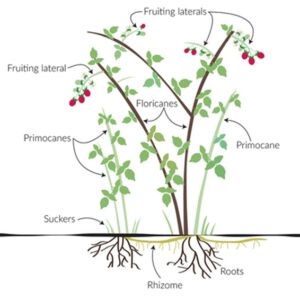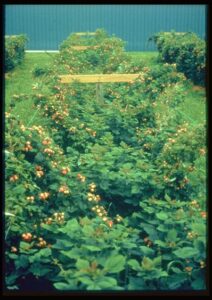What are brambles?
Bramble crops are from the genus Rubus and include blackberries and raspberries. Brambles are among the easiest fruit crops to grow, and the fruit is in high demand due to its exotic flavor and high nutritional value. Raspberries and blackberries can be sold for a greater price per pound than just about any fruit. One of the major challenges with bramble production is that the fruit can be quite perishable. Brambles can be incorporated into a vegetable farm with some key considerations.
Basics
Brambles have perennial root systems and biennial shoot growth (shoots live for 2 years). Brambles require full to partial sunlight and adequate water with good soil drainage to prevent wet feet. The ideal soil is sandy loam with a pH of 6.0-6.5. The desirable range of important nutrients is as follows: Nitrogen (foliar): 2.0-2.8%, Phosphorus: 20-30 ppm and Potassium: 120-180 ppm. Different types of raspberries include red, black, yellow, and purple varieties. Blackberries are categorized by their growing habit (erect, semi-erect, or trailing) and whether or not they have thorns.
Raspberries
Raspberries produce fruit on 2-year-old canes (floricanes). Each year, raspberries produce new shoots (called primocanes), which do not flower or produce fruit until year 2 (when they are floricanes). However, some red raspberry varieties are known as ever-bearing or primocane fruiting types, and they produce a crop in the late summer on floricanes and a second crop in the fall on primocanes. Remove bearing canes (floricanes) each year after harvest. Remove weak, diseased, or damaged canes in early spring. Black raspberries require tip pruning in the summer to encourage branching.
Raspberries are cold hardy, with most varieties well-suited to the Midwest. Red raspberries are the hardiest, although late Spring freeze damage can still occur, especially with extreme temperature fluctuations. Purchase certified virus-free plants and plant in the Spring. Expected productivity is 5-8 years. Raspberries are self-fertile, and the yield is typically 1-1.5 quarts per plant.
Blackberries
Blackberries can produce fruit on 1-year-old wood (primocane-fruiting types) or 2-year-old wood (floricane-fruiting types). Remove bearing canes (floricanes) after harvest each year. Tip pruning in summer is required to encourage branching. Remove weak, diseased, or damaged canes and shorten lateral branches in early spring. For easy management, trellis semi-erect varieties. For primocane-fruiting types, cut canes to the ground in the Fall after frost. New primocanes will grow in Spring (canes will grow, flower, and fruit in one season).
Most blackberries can only withstand -10°F, although new primocane fruiting varieties are slightly more cold hardy. Blackberries are most well-suited to Southern Indiana but can be planted in Northern Indiana with careful site and variety selection. Blackberries are self-fertile. Yield varies from 1 quart per 1-2 row feet for thornless erect types, 1-2 quarts per 1-row foot for thornless erect types, and 4-8 quarts per plant for thornless semi-erect types.
Considerations for Interplanting Brambles & Vegetables
When deciding whether brambles are compatible with their overall operation, growers must consider land, labor, capital, equipment use, time commitment, seasonality, and management skills. Bramble production requires a high initial investment, and slow returns are expected at first. Regarding labor, brambles can be an ideal crop for both small and large farms. However, large farming operations may require additional labor during pruning and harvest. Brambles ripen in late summer and may be ideal for a farm that grows and markets early-to-mid-summer maturing vegetables.
Space availability will determine plant type. Red raspberry plants should be spaced 2 ½ to 3 feet apart, and purple and black raspberries should be spaced 3 to 4 feet apart. Blackberry bushes should be planted 4-6 feet apart (closer spacing for erect and semi-erect types, wider spacing for trailing types). The distance between rows will depend on the equipment but typically ranges from 6 to 12 feet.
Avoid planting brambles where tomatoes, potatoes, eggplant, strawberries, or other crops susceptible to Verticilium wilt have been grown in the previous 4-5 years because the fungus that causes Verticilium wilt can remain in the soil for several years. Also, only plant brambles after field crops if there is no history of using herbicides with long residual activity.
Varieties for Indiana
Blackberries
- Erect Thornless: Ponca, Osage, Apache, Ouachita, Natchez, Arapaho
- Semi-erect Thornless: Triple Crown, Chester
- Thorny: Shawnee
- Primocane-fruiting: PrimeArk45, Black Magic, Freedom, Traveler
Raspberries
- Black Raspberries: MacBlack, Jewel, Bristol, Niwot (primocane-fruiting)
- Red Raspberries-
- Summer: Nova, Titan, Prelude
- Fall: Heritage, Autumn Bliss, Caroline
Additional Resources
Midwest Fruit Pest Management Guide
Raspberries | Purdue Extension HO-44
Blackberry Production Systems in Ohio
Small Fruit Cold Hardiness – Winter Injury in Brambles
UMass Small Fruit Management Guide – Brambles

